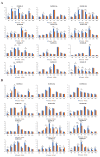Genome-Wide Characterization and Identification of Trihelix Transcription Factor and Expression Profiling in Response to Abiotic Stresses in Rice (Oryza sativa L.)
- PMID: 30634597
- PMCID: PMC6358761
- DOI: 10.3390/ijms20020251
Genome-Wide Characterization and Identification of Trihelix Transcription Factor and Expression Profiling in Response to Abiotic Stresses in Rice (Oryza sativa L.)
Abstract
Trihelix transcription factors play a role in plant growth, development and various stress responses. Here, we identified 41 trihelix family genes in the rice genome. These OsMSLs (Myb/SANT-LIKE) were located on twelve chromosomes. Synteny analysis indicated only six duplicated gene pairs in the rice trihelix family. Phylogenetic analysis of these OsMSLs and the trihelix genes from other species divided them into five clusters. OsMSLs from different groups significantly diverged in terms of gene structure and conserved functional domains. However, all OsMSLs contained the same five cis-elements. Some of these were responsive to light and dehydration stress. All OsMSLs expressed in four tissues and six developmental stages of rice but with different expression patterns. Quantitative real-time PCR analysis revealed that the OsMSLs responded to abiotic stresses including drought and high salt stress and stress signal molecule including ABA (abscisic acid), hydrogen peroxide. OsMSL39 were simultaneously expressed under all treatments, while OsMSL28 showed high expression under hydrogen peroxide, drought, and high salt treatments. Moreover, OsMSL16/27/33 displayed significant expression under ABA and drought treatments. Nevertheless, their responses were regulated by light. The expression levels of the 12 chosen OsMSLs differed between light and dark conditions. In conclusion, our results helped elucidate the biological functions of rice trihelix genes and provided a theoretical basis for further characterizing their biological roles in responding to abiotic stresses.
Keywords: light; phylogenetic analysis; rice; stress response; trihelix transcription factor.
Conflict of interest statement
The authors declare no conflict of interest.
Figures











Similar articles
-
Genome-Wide Identification and Expression Profiling Analysis of the Trihelix Gene Family Under Abiotic Stresses in Medicago truncatula.Genes (Basel). 2020 Nov 23;11(11):1389. doi: 10.3390/genes11111389. Genes (Basel). 2020. PMID: 33238556 Free PMC article.
-
Genome-wide identification and expression profiling of trihelix gene family under abiotic stresses in wheat.BMC Genomics. 2019 Apr 11;20(1):287. doi: 10.1186/s12864-019-5632-2. BMC Genomics. 2019. PMID: 30975075 Free PMC article.
-
[Genome-wide analysis and functional prediction of the Trihelix transcription factor family in rice].Yi Chuan. 2015 Dec;37(12):1228-41. doi: 10.16288/j.yczz.15-196. Yi Chuan. 2015. PMID: 26704948 Chinese.
-
A Meta-Analysis of Comparative Transcriptomic Data Reveals a Set of Key Genes Involved in the Tolerance to Abiotic Stresses in Rice.Int J Mol Sci. 2019 Nov 12;20(22):5662. doi: 10.3390/ijms20225662. Int J Mol Sci. 2019. PMID: 31726733 Free PMC article.
-
[Plant Trihelix transcription factors family].Yi Chuan. 2012 Dec;34(12):1551-60. doi: 10.3724/sp.j.1005.2012.01551. Yi Chuan. 2012. PMID: 23262102 Review. Chinese.
Cited by
-
Trihelix Transcription Factor OsTGS1 Regulates Grain Size and Weight in Rice.Rice (N Y). 2025 Apr 29;18(1):31. doi: 10.1186/s12284-025-00792-6. Rice (N Y). 2025. PMID: 40299154 Free PMC article.
-
Genome-Wide Identification and Expression Analysis of the FAR1-RELATED SEQUENCE (FRS) Gene Family in Grape (Vitis vinifera L.).Int J Mol Sci. 2025 May 14;26(10):4675. doi: 10.3390/ijms26104675. Int J Mol Sci. 2025. PMID: 40429817 Free PMC article.
-
Genome-wide characterization and identification of Trihelix transcription factors and expression profiling in response to abiotic stresses in Chinese Willow (Salix matsudana Koidz).Front Plant Sci. 2023 Mar 3;14:1125519. doi: 10.3389/fpls.2023.1125519. eCollection 2023. Front Plant Sci. 2023. PMID: 36938039 Free PMC article.
-
Physiological and Molecular Responses of 'Dusa' Avocado Rootstock to Water Stress: Insights for Drought Adaptation.Plants (Basel). 2021 Sep 30;10(10):2077. doi: 10.3390/plants10102077. Plants (Basel). 2021. PMID: 34685886 Free PMC article.
-
Genome-wide characterization and expression analysis of GATA transcription factors under combination of light wavelengths and drought stress in potato.Plant Direct. 2024 Apr 24;8(4):e569. doi: 10.1002/pld3.569. eCollection 2024 Apr. Plant Direct. 2024. PMID: 38659972 Free PMC article.
References
MeSH terms
Substances
Grants and funding
LinkOut - more resources
Full Text Sources
Other Literature Sources

